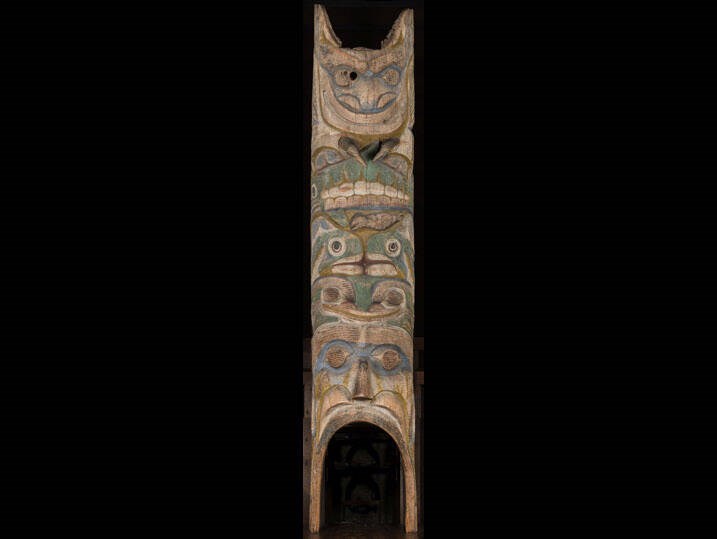A remote First Nation on the Central Coast is calling on the Royal British Columbia Museum to return a totem pole and other artifacts that are considered sacred and were lost by its people more than a century ago.
Hereditary Chief Snuxyaltwa, who also goes by Deric Snow, said the totem and other items, including carved canoes and masks, and regalia associated with potlatch ceremonies, were either taken or sold under duress from the Nuxalk First Nation near Bella Coola from 1900 to the mid-1950s.
Many of the items ended up in museums, including the totem at the Royal B.C. Museum.
Four Nuxalk hereditary chiefs were promised by then-CEO Jack Lohman that the artifacts would be returned after they visited the museum in October 2019 and saw the totem standing in the First Peoples Gallery, the First Nation said.
The pole was taken from the Nuxalk homeland in South Bentinck (Talleomy) south of Bella Coola when people were forced to relocate after a smallpox epidemic around 1900. It was carved by Louie Snuxyaltwa and was a longhouse entrance pole.
Snuxyaltwa has said his great grandfather’s spirit is still in the totem pole and is not at rest.
“The spirit of my great grandfather is stuck there, trapped in that museum,” Snuxyaltwa said in an interview. “The pole must be brought back to free his spirit and for the next generations of our people.
“It is [my] job on behalf of all the hereditary chiefs to bring the pole and artifacts back where they belong.”
Snuxyaltwa said the museum “has done nothing toward repatriating the Nuxalk totem poles and important artifacts.”
Instead, he said, the museum indicated to him in a November email that there is another claim to the totem pole, despite his family’s label on it.
To prove there is no other Nuxalk claim, Snuxyaltwa has obtained signed letters of support for his claim from all 14 hereditary chiefs of the Nuxalk Nation and from the Nuxalk’s elected band council.
He expects the museum to pay for the pole’s transportation back to its original site.
In a statement, the Royal B.C. Museum said it has always been clear that repatriation of the pole would take time, since it is located on the museum’s third floor, and there is no clear path to remove it from the building.
“It was agreed to have a series of planning meetings that include the Nuxalk Hereditary Chiefs and elected officials to co-develop a timeline, a budget to cover the cost of repatriating the pole, and to address other important logistics to ensure the safe transportation of the pole.”
The museum acknowledged the meetings have yet to take place, due in part to the impact of COVID-19, as well as other scheduling challenges.
“The museum looks forward to proceeding with the agreed upon meetings and developing a course of action that will ensure the safe return of this cultural treasure,” it said.
The Nuxalk have received support in their quest from the United Nations’ International Federation for the Protection of the Rights of Ethnic, Religious, Linguistic and Other Minorities.
In a letter to Royal B.C. Museum acting CEO Dan Muzyka, the international organization cited the 2007 UN Declaration on the Rights of Indigenous Peoples, which Canada and the province support.
“We encourage the [Royal B.C. Museum] to expedite the return of Chief Snuxyaltwa and the Nuxalk People’s ancestral totem and other cultural artefacts,” said Michael van Walt van Praag, chairman of the UN group.
“The loss to the people of these spiritual, cultural, historical, and familial objects is incalculable, and delays to their repatriation have been and continue to be particularly painful.”
Snuxyaltwa said the Nuxalk First Nation plans to build a replica pole for the longhouse at its community school. The original pole, when returned, will be placed at its original site.
He said many of the Nuxalk people sold regalia, headdresses and masks dating from 1855 to 1950 because potlatch ceremonies were outlawed under threat of jail. “They sold because the government put so much fear in them,” said Snuxyaltwa.
The Royal B.C. Museum said there had been plans for members of the Nuxalk First Nation to visit the museum’s Indigenous Collections and Research Department to research other potential items for repatriation, but that could not proceed due to COVID protocols.
“As a result, we do not have any specific repatriation requests related to any other cultural items of the Nuxalk people,” the museum said.
The nation has about 1,200 members, said Snuxyaltwa, and has suffered greatly over the years. It was nearly wiped out by smallpox at the turn of the last century, and many members were sent off to residential schools in Alert Bay, Port Alberni and even to the U.S., some never to return.
“This is about reconciliation,” said Snuxyaltwa.
The Nuxalk traditional territory extends from the mouth of the Bella Coola River inland along the Bella Coola Valley and nearby inlets and channels.




